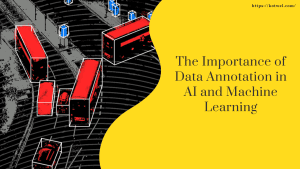Ensuring high-quality data throughout the machine learning lifecycle is crucial for developing models that are both effective and reliable. Here's a practical guide on maintaining data quality at every stage—from collection and preprocessing to training and deployment.
Data Collection: Setting a Strong Foundation
1. Define Data Requirements Clearly:
- Understand and specify what data is needed based on the problem you are solving.
- Identify data sources that can provide reliable and relevant data.
2. Establish Data Collection Protocols:
- Use standardized methods for data collection to reduce errors and ensure consistency.
- Implement automated data collection tools where possible to minimize human error.
Data Annotation: Essential for Supervised Learning
1. Understanding Data Annotation:
- Data annotation is the process of labeling data, making it recognizable for machine learning models. It's the foundation of supervised learning tasks where models learn from labeled examples.
2. Ensuring Annotation Quality:
- Consistency: Establish clear guidelines for annotators to follow, ensuring consistency across data labels.
- Accuracy: Use expert annotators when domain-specific knowledge is crucial, and implement quality checks to verify annotation accuracy.
- Diversity: Annotate a diverse set of data points to cover various scenarios and edge cases, enhancing the model's ability to generalize.
3. Tools and Platforms for Annotation:
- Leverage annotation tools and platforms that streamline the process, offering functionalities like batch labeling, auto-labeling with pre-trained models, and collaborative annotation.
4. Managing Annotated Data:
- Organize annotated data systematically, making it easy to update labels or add annotations as new data becomes available.
- Periodically review and refine annotations to adapt to evolving data characteristics or project goals.
Data Preprocessing: Ensuring Cleanliness and Relevance
1. Data Cleaning:
- Identify and handle missing values, either by imputation or by removing data points.
- Detect and correct errors or outliers in the data through techniques such as normalization or clipping.
2. Data Integration and Transformation:
- Integrate data from multiple sources to enrich the dataset while ensuring the consistency of data formats and units.
- Apply transformations such as scaling and encoding to make the data suitable for machine learning models.
Data Quality Assessment: Continuous Evaluation
1. Use Data Profiling Tools:
- Employ tools to regularly assess data quality, providing insights into data accuracy, completeness, and consistency.
- Examples of tools include Talend, Informatica, and custom scripts that perform sanity checks.
2. Implement Data Validation Rules:
- Define and automate data validation rules that run at intervals or in real-time to ensure ongoing data quality.
- Utilize assertions in data pipelines to check for data anomalies and integrity issues.
Model Training: Leveraging High-Quality Data
1. Feature Selection and Engineering:
- Use feature selection techniques to eliminate redundant or irrelevant features which can introduce noise into the model.
- Engineer new features that can provide significant insights into the patterns within the data.
2. Cross-Validation Techniques:
- Apply cross-validation methods to evaluate the effectiveness of your model on unseen data.
- Use these insights to continuously refine the data inputs and preprocessing steps.
Deployment and Monitoring: Ensuring Stability in Production
1. Monitoring Data Drift:
- Set up systems to monitor and alert for data drift, which can degrade model performance over time.
- Use statistical tests and visualization tools to compare incoming data against the data the model was trained on.
2. Continuous Integration of New Data:
- Regularly integrate new, high-quality data into the model to refine and improve its predictions.
- Automate the retraining process to include the latest relevant data while ensuring quality.
Tools and Technologies to Support Data Quality
- Data Quality Software: Tools like IBM InfoSphere QualityStage and SAS Data Management help automate many aspects of data quality control.
- Version Control Systems: Use Git or DVC for data version control to track changes and maintain the integrity of your data sets.
- Automated Testing Frameworks: Implement frameworks such as Great Expectations or Apache Griffin for continuous data quality testing and validation.
Maintaining data quality is an ongoing process that requires vigilance and adaptation to new challenges and data sources. By implementing these practices, machine learning teams can ensure their models are built on a foundation of reliable and accurate data, leading to better performance and more trustable outcomes.
High-quality AI Training Data Services at Kotwel
Building on these essential steps for enhancing data quality, it's crucial to choose the right partner for your AI training needs. Kotwel excels in providing high-quality AI training data services. Catering to a diverse clientele globally, Kotwel's AI data solutions underscore its reputation as a dependable partner in AI innovation, helping projects achieve excellence and accuracy from the ground up.
Visit our website to learn more about our services and how we can support your innovative AI projects.
Kotwel is a reliable data service provider, offering custom AI solutions and high-quality AI training data for companies worldwide. Data services at Kotwel include data collection, data labeling (data annotation) and data validation that help get more out of your algorithms by generating, labeling and validating unique and high-quality training data, specifically tailored to your needs.
You might be interested in:
What is Data Annotation? Data annotation is the process of labeling data for supervised machine learning. This simply means adding tags or labels to data so that algorithms can learn from it. For example, if you wanted to teach a machine learning algorithm to […]
Read MoreWhat is Data Annotation for Computer Vision? In computer vision, data annotation is the process of annotating samples with metadata for use in machine learning algorithms. While data annotation could be used to annotate any type of sample, it is most commonly used in […]
Read MoreImage annotation is the process of adding structure to an image, providing descriptions for different elements in that image. Image annotation can be used for a variety of purposes, such as solving a visual problem more efficiently or improving the accuracy of training data […]
Read More




